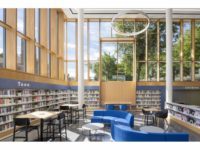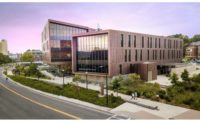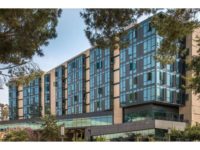SOLARBAN Glass Adorns Three 2021 Top 10 Green Buildings

Vitro Architectural Glass announced that three of the 10 buildings selected by the American Institute of Architects (AIA) Committee on the Environment (COTE®) as the top green building projects of 2021 were glazed with Solarban® solar control, low-emissivity glasses. The award-winning projects include:
- Rockwell Integrated Sciences Center; Lafayette College; Easton, Pennsylvania – Designed by Boston-based Payette, the 103,000-square-foot structure replaced the college’s energy-intensive biology building with a LEED® Platinum-certified office and classroom center. Featuring an open, airy “vertical commons,” daylit with energy-efficient Solarban® 70 glass, the new science building combines an array of energy-saving products and strategies to generate a predicted EUI (Energy Use Index) of 76 kBtu per square-foot, per year, which places it in the 99th percentile for energy performance among cold-climate labs. Constructed as part of a campus-wide initiative to reduce carbon emissions, the project produced a net 40% reduction in operating carbon emissions compared to the existing biology building.
- Hayden Library Reinvention; Arizona State University; Tempe, Arizona – A campus landmark since 1966, the Hayden Library at Arizona State University was completely re-imagined by architectural firm Ayers Saint Gross to function as a model of sustainable design while retaining its cherished architectural heritage. Double-height insulating glass units (IGUs) fabricated with Solarban® 70 glass highlight a new ground-level plaza that reconnects the library tower to the surrounding campus community. Salvaged granite panels and stained glass characterize the façade above the plaza, which features new double-pane IGUs fabricated with Solarban® 70 glass as energy performance upgrades to the library’s existing single-pane glazing. Combined with LED lighting, demand-controlled ventilation and a rooftop solar array, the glass enables the building to achieve an EUI of 42 kBtu per square-foot, per year, a 32% reduction in energy use compared to its pre-renovation performance.
- Life Sciences Building; University of Washington; Seattle – Building integrated photovoltaic (BIPV) panels and a highly transparent glass façade fabricated with Solarban® 72 Starphire® glass are signature design elements for the new Life Sciences Building at the University of Washington. Designed by Perkins+Will, the 12,400 square-foot, seven-story building achieves its sparkling jewel-box design despite a deceptively narrow 48.2% window-to-wall ratio (WWR) that helps reduce energy use by 80 percent compared to baseline structures of its type.
Featuring a proprietary triple-silver, solar control, low-e coating, Solarban® 70 glass combines visible light transmittance (VLT) of 64% with a solar heat gain coefficient (SHGC) of 0.27 in a standard one-inch IGU. Solarban® 72 Starphire® glass unites the same coating technology with Vitro Glass’s premium low-iron glass to achieve heightened levels of clarity and solar control performance. In a standard one-inch IGU, Solarban® 72 Starphire® glass has VLT of 68% and a SHGC of 0.28.
For more information about the full range of sustainable architectural glass products available from Vitro Architectural Glass, please visit www.vitroglazings.com or call 1-855-VTRO-GLS (887-6457). Information on satisfying LEED and other green building objectives with Vitro Glass products is available at www.vitroglazings.com/leed.
Looking for a reprint of this article?
From high-res PDFs to custom plaques, order your copy today!





